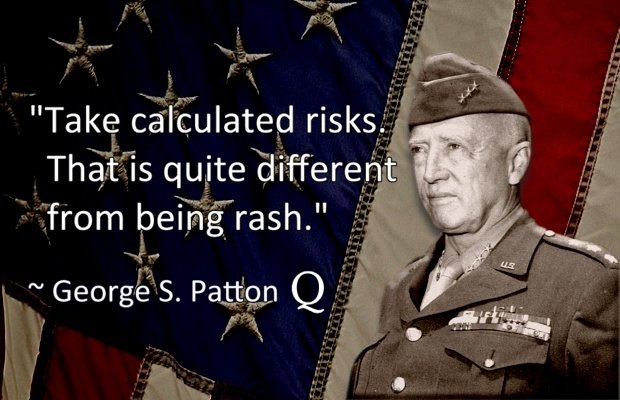When General George S. Patton said, “Take calculated risks. That is quite different from being rash,” it clarified his more famous quote, “A good plan, violently executed now, is better than a perfect plan next week.”
Today, a variation of the quote, “A good plan today is better than a perfect plan tomorrow,” has become a popular business axiom. However, Patton’s original quote, intended for military application, was perceived by some to be indicative of a tendency in Patton to conceive and execute rash, impulsive battle plans. Yet, even though Patton could be uncooperative and was prone to making embarrassing gaffes, his successes were undeniable. Moreover, the respect and admiration felt for him by the men he commanded were unquestionable.
Generals Eisenhower and Marshall had concerns about Patton’s temperament and reliability when they selected Omar Bradley, Patton’s subordinate, to lead the Allied invasion of Europe during World War II. They had no doubt about Patton’s capacities but saw Bradley as the more cooperative and dependable general for such a high-stakes military operation. Despite this, the Germans were convinced that Patton was the best general the allies had and fully expected him to lead the allied invasion forces. Consequently, they monitored his movements obsessively.

Operation Fortitude
Patton was put to use in a great deception known as Operation Fortitude, whereby the German’s intercepted unreliable intelligence about a great army to be led by Patton in an invasion to take place at the Pas de Calais. The operation involved decoys, props, strategic troop movements, fake radio signals and the use of counter-intelligence agents. The plan worked and helped make the Normandy Invasion the success it was.
Patton was given the command of the U.S. Third Army and next saw action in Normandy in July 1944. Even though he faced less opposition than the three other allied field armies, he demonstrated his talent for flexible innovation and exploited allied air superiority and intelligence to make an awe-inspiring drive into northern France, covering nearly one hundred kilometres in the first two weeks. His attack was halted near the Moselle River for lack of fuel.
This gave the Germans time to strengthen their forces at nearby Metz. In the ensuing battle, The Battle of Metz, the two armies stood deadlocked for more than two months and both sustained heavy casualties. Metz finally fell to the Third Army in December 1944, but the engagement is not generally considered to be one of Patton’s most dynamic or decisive battles. Yet, in the weeks to follow, Patton’s military leadership would become legendary.
The Battle of the Bulge
Mini Bio: George S. Patton
George S. Patton was born on 11 November 1885 in San Gabriel, California. He gained fame as a U.S. Army general during World War II and is best remembered for his dynamic leadership of the U.S. Third Army during the allied invasion of Europe.
Education:
- Homeschooled until 11 years of age
- Stephen Clark’s School for Boys – Pasadena, California
- United States Military Academy – West Point, New York
War Service:
- The Pancho Villa Expedition 1915 -1917 (Rank 1st Lieutenant)
- World War I – France 1917 (Rank Captain)
- World War I – Germany 1918 (Rank Lieutenant Colonel)
- World War II – North Africa 1942 (Rank Brigadier General | Lieutenant General)
- World War II – Sicily 1943 (Rank Lieutenant General)
- World War II – France, Luxemburg and Belgium 1944 (Rank Lieutenant General)
- World War II – Germany 1945 (Rank General)
Nicknames:
- “Bandito”
- “Old Blood and Guts”
Patton operated in the African, Mediterranean and European theatres of World War II but is best remembered for his dynamic leadership of the Third Army in France, Belgium, and Germany.
Biographer, Ladislas Farago, wrote that Patton was the allied general most feared by the German high command which monitored his whereabouts obsessively.
In spite of that, Patton was a controversial figure in the United States: he frequently made public pronouncements that were unbefitting his office and once slapped two shell shocked soldiers for cowardice.
Patton died on 21st December 1945 from injuries sustained in a car accident during the allied occupation of Germany.
He was laid to rest in the Luxembourg American Cemetery and Memorial with men of the Third Army who fell under his command.
References
Farago, L., 1963. Patton: Ordeal and Triumph. New York: Dell Pub. Co.
McNeese, T., 2003 Great Battles Through the Ages: Battle of the Bulge, New York City: Chelsea House Publications
En.wikipedia.org. 2021. George S. Patton. [online] Available at: https://en.wikipedia.org/wiki/George_S._Patton [Accessed 17 February 2021].
